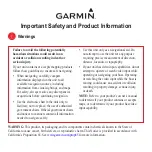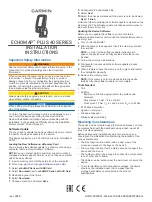
Page 13
The information contained in these documents is confidential, privileged and only for the information of the intended recipient and may
not be used, published or redistributed without the prior written consent of Wildlife Computers.
days of data. Originally created for Wildlife Computers support purposes, the message type is now available
to all.
Orientation Data
This data product characterizes the vertical orientation over time of a single-point mount MiniPAT.
Orientation data uses the onboard accelerometer and is designed to detect activity. It is only available on
shorter deployments with the archive sample interval is 1 second.
For each UTC day, one message is generated that contains two-hour summary periods with:
1.
Time upright
2.
Number of times the tag was
knocked down
3.
Wet/dry summarization
There are adjustable parameters for this data product:
1.
The knockdown detector identifies changes in tag orientation. Select the threshold that qualifies a
change in acceleration as a knockdown event.
2.
To determine the amount of time a tag spends upright versus tilted, a threshold definition of
upright is needed.
Daily Data cannot be duty-cycled.
Figure 10—Daily Message data products. Screen capture shows Light-level messages generated daily, Light Attenuation
calculations turned on, Daily Data messages turned off, and Orientation Data turned on.
Time-Series Messages
MiniPAT tags have the ability to send time-series depth and/or temperature data through Argos. Time-
series provides low frequency reporting of sensor data for instruments which may never be recovered.
Sampling Interval
Time-series messages can be generated using one of five sample intervals (75, 150, 300, 450, 600 seconds).
This determines the number of Argos messages generated per day.
The time-series sample interval is
entirely independent of, and unrelated to, the archive sample rate.
48 summarized samples, covering
one message period, will fit into one Argos message. Messages are transmitted in sequential order to
maximize the probability of receiving continuous runs of data.














































